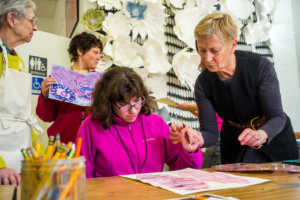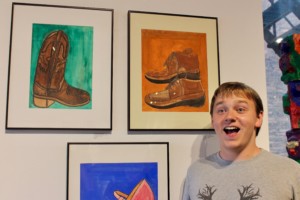Sandy Newman was working as a dance therapist for people with disabilities and, out of the living room in her Stockbridge home, founded Community Access to the Arts (CATA) in 1993. She wanted to connect people with disabilities to the broader Berkshire community, so Sandy began taking her students out to museums and performances and was surprised that most of her students’ experiences with cultural institutions were extremely limited. “Here are people who are surrounded by world-class arts and culture and most of them had not had the chance to experience any of it. That had to change,” says Margaret Keller, Executive Director of CATA.

Photo Credit: John Dolan
The idea caught fire. In realizing she could connect people within the community, Sandy started building a network and a team. Together with Dawn Lane, they created a Board of Directors that helped guide CATA and was key in growing such an important community organization. Today, CATA provides 1,300 arts workshops a year and serves more than 700 CATA artist with disabilities, but the message remains the same: to nurture and celebrate the creativity of people with disabilities. The organization gives people with disabilities the chance to explore interests and discover hidden talents, then share them with the community.
Margaret has been Executive Director at CATA for four years, but her passion for creating opportunities for marginalized communities to engage with the arts spans her entire career. She’s helped grow CATA into a countywide organization, doubled school programs, and increased CATAs Program Partners by 44%. Margaret has also recently joined the 1Berkshire Board of Directors. We caught up with her to learn more about CATA and her exciting story.
Hi Margaret! We are so happy that you’re sharing your story with us. Could you tell us about your journey, what brought you to the Berkshires and to CATA?
My story really begins in Chicago. I was at the University of Chicago, first as a graduate student then working for the humanities division, where I launched an alumni magazine and planned a day-long festival of the humanities, inviting the community onto a campus that was often seen as an intellectual fortress, apart from its neighborhood. From there, I moved to an incredible and at the time, very new organization, the Chicago Humanities Festival, a citywide celebration bringing art and ideas to over 40,000 people throughout Chicago over 3 weeks. I directed programs and helped turn the Festival from an event into a year-round institution.
Why did you leave Chicago for the Berkshires?
My husband, a writer and novelist, got a job as a professor at Bard College at Simon’s Rock. Once we were here, I wanted to continue to develop my own career, and when I found CATA, its work immediately struck a chord. So much of what I’ve done professionally was expanding access to the arts, and it was exhilarating to find an organization that was doing this work in such a profound and meaningful way.
How did you learn about CATA?
Not long after we moved to the Berkshires, I attended the annual CATA Gala and was drawn into performances by CATA artists. I remember sitting in the audience, awestruck. From that first moment, I was hooked. I saw disability in a new way–and I saw the power of art to transform our perceptions and connect us with others.
You mentioned community before. How has CATA leveraged the Berkshires to create an opportunity for people with disabilities?
 We have program partners that help us connect with our CATA artists. Organizations like Berkshire County Arc, BFAIR, Riverbrook Residence, United Cerebral Palsy of Berkshire County, and seven different school districts including Pittsfield Public Schools have really played an integral role in expanding our programming.
We have program partners that help us connect with our CATA artists. Organizations like Berkshire County Arc, BFAIR, Riverbrook Residence, United Cerebral Palsy of Berkshire County, and seven different school districts including Pittsfield Public Schools have really played an integral role in expanding our programming.
We also have vital partnerships with cultural organizations. This year, we are proud to have the works of our CATA artists displayed at the Clark Art Institute and Lichtenstein Center for the Arts, and performances at Shakespeare & Company and The Mount. These partnerships are key because that’s how we bring our artists out to the world. It’s how we fulfill our mission to reach the broader community and expand the public perception of people with disabilities.
The story of CATA is a story of the Berkshires. Sandy recognized we are a world-class destination for the arts and at the same time a place where a group of people has been historically underserved. Creating a bridge between the two was nothing short of brilliant. In another community, this might not have happened. It might have remained an idea that never flourished. But here, because so many people have been willing to stand with us to create the community that they want, we exist.
How can someone get involved?
Save the date! Join us May 12th, and May 13th for our Annual Gala and Performance Weekend. It’s what really drew me to the organization in the first place. I have to say, one of the many reasons our gala hooked me is because it is not your typical gala. It’s our mission in action. At the heart of the evening are powerful performances by our CATA artists, led by our talented CATA faculty. The range of work they create for the show is astounding. There are moments that are incredibly moving and provoke tears, and other moments that are side-splittingly funny. It’s a full artistic experience. Our theme this year is CATAsfaction – meaning all things that satisfy.
Invitations go out at the end of March. The Sunday matinee is family friendly and a great time; we hope that you can join us!
For more information on CATA visit www.cataarts.org or call (413) 528-5485.

